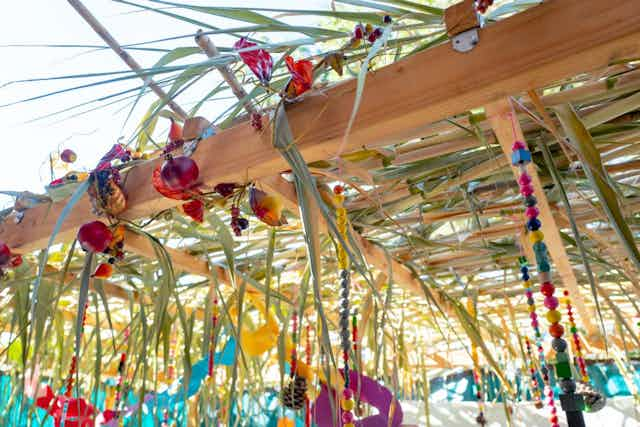Sukkot is a Jewish festival that follows right on the heels of Rosh Hashana and Yom Kippur, Judaism’s High Holy Days. The harvest holiday, which begins on Sept. 29, 2023, lasts for seven days when celebrated in Israel and eight days when celebrated elsewhere.
Like many Jewish rituals and traditions, from lighting Friday night candles to hosting Passover seders, Sukkot is primarily celebrated in the home – or rather, in the yard. Translated as the “Festival of Booths,” Sukkot is celebrated in an outdoor structure called a sukkah, which is carefully built and rebuilt each year.
As a Jewish Studies scholar, much of my work looks at how diverse Jewish American identities are today. From intermarried families, to Jews of color, to Jewish communities from all over the world, there have always been a myriad of ways to be Jewish – and home-based holidays like Sukkot help people honor all these parts of their identities.
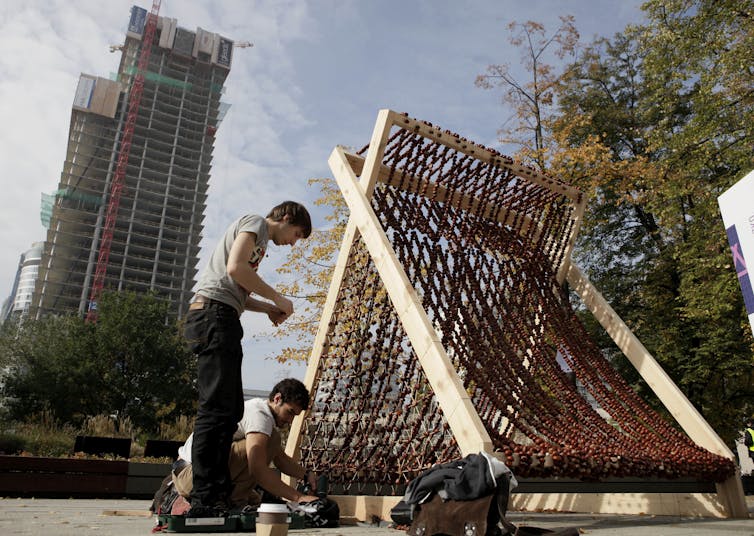
Harvest holiday
Held during the autumn harvest, Sukkot likely has origins in huts that ancient farmers erected so they could sleep in the fields. Yet tradition also says that these booths represent the tents that the Israelites lived in while they wandered the desert for 40 years following the Exodus, their escape from slavery in Egypt.
Some aspects of Sukkot happen in the synagogue, including special prayers and readings from the Bible. Yet the main action takes place at home, in the backyard sukkah – the singular form of the word “sukkot” in Hebrew. For Jews who observe the holiday, tradition says to start building the sukkah as soon as possible after Yom Kippur, the Day of Atonement; some people even start building the structure are soon as they have broken their 25-hour fast.
The makeshift walls, of which there must be at least three, can be made out of anything one wants, from pre-made walls printed with blessings said during the holiday to tablecloths or rugs. People often decorate to say something about who they are: photos of Jerusalem, quilts made by relatives. I have always imagined that, if I had a sukkah, I would use Indian tablecloths for walls, merging that piece of my heritage with my religion.
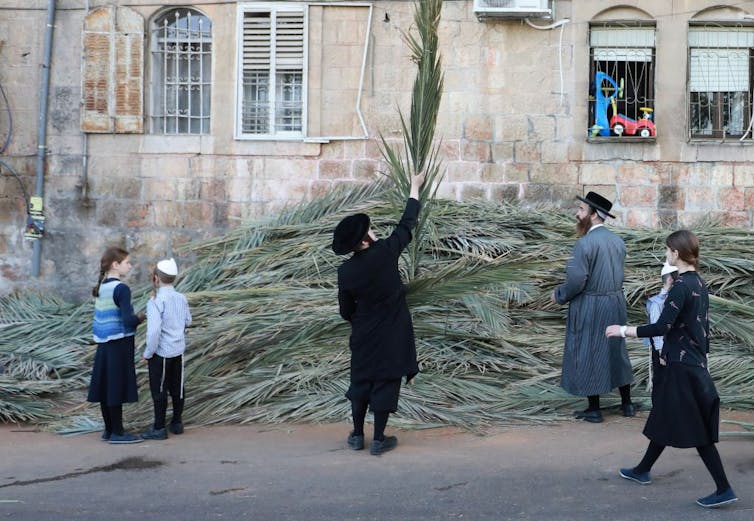
The roof, however, is supposed to be made out of natural materials like palms or branches; one friend of mine likes to use cornstalks. The roof should provide shade but must allow gaps to see the stars. Those of us who do not have yards can get creative with our balconies or, like me, drop hints that they would welcome invitations to other people’s sukkot. One New Yorker friend turns her living room into a faux sukkah – you cannot see the stars, but it is filled with nature and decorations.
In the United States, many families decorate their sukkot with classic elements of the American harvest season: corn husks, colorful dried ears of corn, harvest gourds and even the occasional bale of hay. In New Mexico, you sometimes see “ristras,” the decorative red strings of chiles that hang from porches.
The traditional plants of Sukkot, however, are four distinct species: a citrus fruit called an etrog, and fronds of palm, myrtle and willow, which are bound together and referred to as the “lulav.” The lulav and etrog are blessed and shaken together on a daily basis throughout the festival.
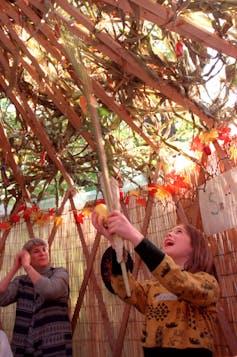
Our yard, our holiday
Beyond this, Jews are supposed to live in the sukkah for the festival, which technically means eating and sleeping there. But as with all religious holidays, individuals celebrate Sukkot in a wide variety of ways.
Many Jews do not construct sukkot at all, let alone sleep in them for a week. Of those who do, some sleep every night in the sukkah; some have one night of family “camping”; others do not sleep in it at all. Many people entertain guests there: I have been to many a meal – and one graduate seminar – in sukkot all over the country.
It is the fact that so much of Sukkot is held at home that accounts for the holiday’s immense flexibility. Like at Passover, most Jews who celebrate Sukkot encounter it in spaces where people can honor their values, cultures or histories.
What this looks like is as diverse as the world of American Jews.
For instance, for the years that I taught outside of Philadelphia, I attended a multinight open house, called “Whiskey in the Sukkot,” hosted by an interfaith couple. The Jewish wife explains that when she and her husband – a whiskey aficionado from Appalachia – got married, his thought process went: “harvest festival, grain, whiskey.”
Each year, he curates a selection to share with his guests, with new offerings for each night. Accompanied by pungent cheeses and other nibbles, this festival of whiskey offered him a way to make the holiday his own. In the process, the couple created an event that welcomes their Jewish – and non-Jewish – communities.
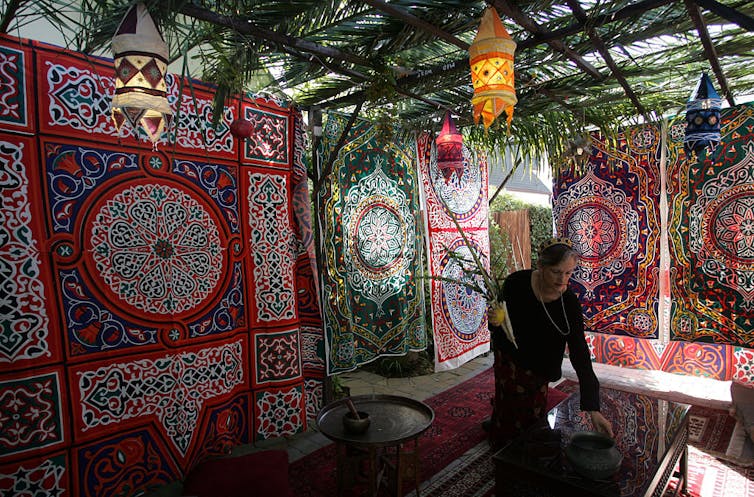
On his Afroculinaria blog, the chef, culinary historian and author Michael Twitty created a Southern harvest soup for Sukkot, which he notes uses “traditional Southern ingredients and flavors.” His soup is vegetarian, but he also offers a “trayf alternative,” meaning a version that is not kosher – a recipe that swaps out olive oil for bacon grease. Even in the most liberal Jewish settings, one cannot usually serve pork in a synagogue setting, but this is your Sukkot table. If you, like most American Jews, do not keep kosher, why not go full-on Southern in your flavors?
Not everyone sees their full identity reflected on Sukkot. Emily Bowen Cowen, a cartoonist who is Jewish and Muscogee (Creek), has written a comic called “My Sioux-kot,” imagining what Sukkot could look like if, like many contemporary Passover celebrations, it emphasized social justice. Cohen muses on the parallels she saw between Sukkot celebrations and 2016 protests to block an oil pipeline at the Standing Rock reservation in North Dakota. At the time, both were events where people talked about valuing nature as sacred. Yet no one mentioned the protests in the sukkot she visited that week.
Indeed, some Jews are finding ways to realize the social justice potential in the holiday. Fiber artist Heather Stoltz used a sukkah as the basis for an art exhibition called “Temporary Shelter,” decorating its walls with stories of unhoused New Yorkers and with art made by children staying in the city’s shelters.
Perhaps the time will come when Sukkot, too, becomes infused with possibilities for a more just future.

